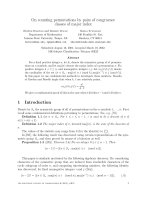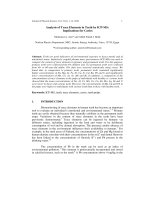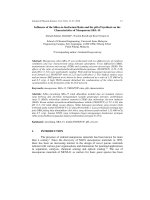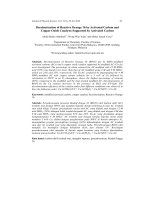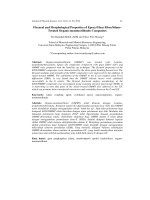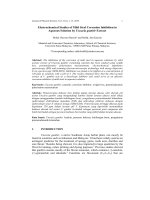Báo cáo vật lý: "ON COUNTING CERTAIN PERMUTATIONS USED FOR SPEECH SCRAMBLING" pps
Bạn đang xem bản rút gọn của tài liệu. Xem và tải ngay bản đầy đủ của tài liệu tại đây (221.9 KB, 9 trang )
Journal of Physical Science, Vol. 17(2), 131–139, 2006
131
ON COUNTING CERTAIN PERMUTATIONS USED FOR SPEECH
SCRAMBLING
B. Jayaramakrishnan
1
, Rajesh Vijayaraghavan
2
and V. Ravichandran
3
1
School of Management, Circuit House Area (East),
Jamshedpur 831 001. Jharkhand, India
2
Department of Computer Science, Courant Institute of Mathematical Sciences
New York University, New York, NY-10012, USA
3
School of Mathematical Sciences, Universiti Sains Malaysia,
11800 USM Pulau Pinang, Malaysia
*Corresponding author:
Abstract: The shift factor of a permutation is the average of the displacement of
elements. In this paper, we count the number of permutations having maximum shift factor
in which adjacent elements not appearing together.
Keywords: speech scrambling, key generation, permutations, derangements, shift factor,
residual intelligibility
1. INTRODUCTION
In a scrambling system, the signal is encrypted by rearranging the input
(plain text) data using permutations. When the signal is divided into portions or
sub-bands, the method directs the rearrangement or jumbling the order of these
portions or sub-bands. This rearrangement is enabled by a key and the inverse of
this key would decrypt back the original data. The scrambling works with
permutation as the key element for encryption and its inverse permutation as the
key for decryption. However, not all of these permutations generated result in a
scrambled signal with acceptably low Residual Intelligibility (RI). The prime
requirement of any encryption algorithm is that the RI should be minimized, i.e.
after permutation one should not be in a position to decipher any details from the
permuted data. The problem of key selection is therefore an important issue in the
design of a scrambling system.
On Counting Certain Permutations Used for Speech Scrambling
132
The following are examples of permutations that can minimize RI:
• C1 (Derangements) permutations whose elements are displaced from
their original position.
• C2 Permutations whose elements do not retain their relative
adjacency
with respect to the original permutation. Thus if the
permutation is given by Eq. (1) below, then
i
p
and
1i
p
+
should
not be adjacent, that is,
1
1.
ii
p
p
+
+
≠
• C3 Permutations with maximum shift factor. The shift factor of a
permutation is defined below.
A rearrangement
1
p
,
2
p
, ,
n
p
of 1, 2, 3, , n is called a permutation of
degree n. This permutation can be written as
12
1 2
n
n
p
p
pp
⎛⎞
=
⎜⎟
⎝⎠
(1)
and for the sake of simplicity we write this permutation as
12
, , ,
n
p
pp. For a
permutation p of degree n, given by Eq. (1), the shift factor is defined by
1
1
||
n
pi
i
ip
n
α
=
=−
∑
.
The order of displacement (OD) of a permutation p, given by Eq. (1), is
defined by
1, ,
() min | |.
in i
OD p i p
=
=−
…
Thus the minimum distance between an element’s original position and
its displaced position is the OD. Derangement is a permutation where no element
retains its old position after being subjected to permutation or in other words it is
a permutation for which
. Thus a derangement is a permutation with an OD
of at least one.
i
ip≠
By using computer programs, Mahadeva Prasanna et al. [1] counted the
number of permutations satisfying various combinations of the above conditions
C1–C3. Ravichandran et al. [2] developed recurrence relations for counting the
Journal of Physical Science, Vol. 17(2), 131–139, 2006
133
permutations except for the two cases: permutations satisfying (i) both C1 and C2,
and (ii) both C2 and C3.
Our main result in this paper is a recurrence relation for the number of
permutations satisfying both C2 and C3. Since the proof of our main result
depends on the description of the permutations having maximum shift factor, we
first review this and also provide a summary of the already known results.
2. PERMUTATION WITH THE MAXIMUM SHIFT FACTOR
High shift factor is essential for ensuring minimum or zero RI, since the
permutations with high shift factor displaces the elements much farther. If the
shift factor is taken to be the maximum possible value, we can describe all the
permutations with the maximum shift factor.
The following theorem gives the value for the maximum shift factor
among all permutations of degree n.
Theorem 1. The maximum shift factor among all permutations of degree n is
given by
( )
2
1
( )
22
max
n
neven
n
n odd
n
α
⎧
⎪
⎪
=
⎨
⎪
−
⎪
⎩
The maximum shift factor is attained for the permutations described in the
Subsections 2.1 and 2.2.
Essentially, the proof of Theorem 1 depends on the following result
which can be verified by a direct computation:
Lemma 1. Let p and p' be permutations given by
1
1
n
ac n
p
p
bd p
⎛⎞
=
⎜
⎝⎠
⎟
(2)
and
On Counting Certain Permutations Used for Speech Scrambling
134
1
1
n
ac n
p'
p
dbp
⎛⎞
=
⎜
⎝⎠
⎟
(3)
and
p
α
,
p'
α
be the shift factors of p, p' respectively. If max {a,b} < min {c,d},
then
pp'
α
α
< .
In the case of even degree permutations, for any permutation other than
those given in Subsection 2.1, we have elements satisfying the conditions of the
Lemma. Therefore, the new permutation obtained using the Lemma will have
higher shift factor. This can be seen directly as follows. If the permutation is not
the one in Subsection 2.1, then one of the element
i
ap
=
, 1 ,
i
ip m
≤
≤ will
be moved to the element
j
bp
=
where
1 ,
j
jp m
≤
≤
. Correspondingly, one
of the elements
,
k
cp= 1 , 2
k
mkpm
+
≤≤ will be moved to the element
where . Now max {a,b} < m and min {c,d} < m+1
and hence max {a,b} < min {c,d}. Therefore, the permutation obtained by
interchanging the numbers b and d will have higher shift factor. This proves that
the permutations given in Subsection 2.1 are the permutations with maximum
shift factor. See Ravichandran et al. [2] for the complete proof.
l
dp= 1 , 2
l
mlp+≤ ≤m
2.1 Permutations of Even Degree Having Maximum Shift Factor
Let n be an even integer, say, n = 2m, m + 1. In this case, the following
permutations have shift factor n/2:
(4)
12 1 2
1 2 1 2
mm m
mm m
p
pp p p p
+
+
⎛⎞
=
⎜⎟
⎝⎠
where
1
p
,
2
p
, ,
m
p
is a permutation of m + 1, m + 2, , 2m and
1m
p
+
,
2m
p
+
,
,
2m
p
is a permutation of 1, 2, , m. It should be noted that
for and for 1.
ii
pi im pi im≥≤ ≤≥+
Journal of Physical Science, Vol. 17(2), 131–139, 2006
135
Also
11 1 1
()and
mm m m
im
ii i i
.
i
p
mi p i
+
== = =
=+ =
∑∑ ∑ ∑
The shift factor α is given by
2
n
m
=
(see Ravichandran et al. [2].)
2.2 Permutations of Odd Degree Having Maximum Shift Factor
Let n be an odd integer, say, n = 2m + 1, m + 1. In this case, permutations
in the following classes have the shift factor (n/2) – (1/2n).
This maximum is attained for the permutations described in the following
three classes:
Class I consists of permutations of the form
12 2 21
1 2 1 2 2 1
1
mm
mm m m
pp pm p p
++m
+
++
⎛⎞
⎜⎟
+
⎝⎠
(5)
where
1
p
,
2
p
, ,
m
p
is a permutation of m + 2, m + 3, , 2m + 1 and
2m
p
+
,
3m
p
+
, ,
21m
p
+
is a permutation of 1, 2, , m.
Class II consists of permutations of the form
12 1 2 21
1 2 1 2 2 1
mm m m
mm m m
pp p p p p
++ +
+
++
⎛⎞
⎜⎟
⎝⎠
(6)
where
1
p
,
2
p
, ,
1m
p
+
is a permutation of m + 1, m + 2, , 2m + 1 and
2m
p
+
,
3m
p
+
, ,
21m
p
+
is a permutation of 1, 2, , m.
Class III consists of permutations of the form (6) where
1
p
,
2
p
, ,
m
p
is a
permutation of m + 2, m + 3, , 2m + 1 and
1m
p
+
,
2m
p
+
, ,
21m
p
+
is a
permutation of 1, 2, , m + 1.
On Counting Certain Permutations Used for Speech Scrambling
136
The permutations in class I are those permutations in class II and III which fix
m + 1.
The following theorems give the number of permutations satisfying the
conditions C1, C2, C3 respectively.
Theorem 2. The number of derangement, or permutations with all the elements
displaced from their original positions, is
00
(1)
!(1)
!
n
nn
n
n
rr
n
dn nr
r
r
==
⎛⎞
−
()!
=
=− −
⎜⎟
⎝⎠
∑∑
Theorem 3. Let
denotes the number of permutations of degree n satisfying C2.
Then
n
t
1
(1)!11 (1)
.
2! 3! ( 1)!
n
n
n
t
nn
+
⎡⎤
+−
=−+⋅⋅⋅+
⎢⎥
+
⎣⎦
The above theorems can be found in Vilenkin [3]. Also the following recurrence
relation is satisfied:
12
( 1) ( 2) ,( 4)
nn n
tnt ntn
−−
=
−+− ≥
23
1, 3.tt
=
=
(See Ravichandran et al. [2].)
Theorem 4. The number of permutations of degree n with maximum shift factor is
2
2
!
2
( )
( )
1
!
2
n
n
neven
c
n odd
n
n
⎧
⎡⎤
⎛⎞
⎪
⎜⎟
⎢⎥
⎝⎠
⎪⎣ ⎦
=
⎨
⎡⎤
⎪−
⎛⎞
⎜⎟
⎢⎥
⎪
⎝⎠
⎣⎦
⎩
The result follows by counting, since the permutations with maximum
shift factor are known. For example, when n is odd, we need to count the distinct
permutations in classes I, II, and III. Since all the permutations in class I belong to
both the classes II and III, we subtract the number of permutations in class I from
Journal of Physical Science, Vol. 17(2), 131–139, 2006
137
the combined permutation of class II and class III. The proof is explained in detail
in Ravichandran et al. [2].
The following result gives the number of permutations satisfying both C1
and C3.
Theorem 5. The number of derangements with maximum shift factor is
2
2
!(
2
1
(1) ! ( )
2
n
n
neven
f
n
n n odd
⎧
⎡⎤
⎛⎞
⎪
⎜⎟
⎢⎥
⎝⎠
⎪⎣⎦
=
⎨
⎡⎤
⎪−
⎛⎞
−
⎜⎟
⎢⎥
⎪
⎝⎠
⎣⎦
⎩
)
We sketch the proof when n is even. Set n = 2m, m + 1. The following
permutation with
12
, , ,
m
p
pp as a permutation of m + 1, m + 2, , 2m and
12 2
, , ,
mm m
p
pp
++
as a permutation of 1, 2, , m will have the maximum shift
factor and also is deranged as seen in
12 2 11
1 2 1 2
mm m m
mm m
p
pppp
++
+
⎛⎞
⎜⎟
⎝⎠
p
Hence the number of derangements with maximum shift factor in this case is
2
(!)(!) !.
2
n
mm
⎡⎤
⎛⎞
⋅=
⎜⎟
⎢⎥
⎝⎠
⎣⎦
Similar proof can be given when n is odd.
The following theorem gives the number of permutations satisfying all
three conditions C1, C2 and C3.
Theorem 6. The number of permutation of degree n with maximum shift factor in
which no element is fixed and no adjacent elements are mapped to adjacent
elements is [2].
2
2
1 1 1
22 2
(
2 (
n
n
nn n
n even
a
t t t n odd
−+ −
⎧
⎪
=
⎨
−
⎪
⎩
)
)
t
On Counting Certain Permutations Used for Speech Scrambling
138
3. NUMBER OF PERMUTATIONS SATISFYING C2 AND C3
In this section, we count the number of permutations having maximum
shift factor with adjacent elements not appearing together.
Theorem 7. The number of permutations with maximum shift factor and adjacent
elements not appearing together is
2
2
111
222
()
2 ( )
n
n
nnn
t n even
b
t t t n odd
−+−
⎧
⎪
⎪
=
⎨
−
⎪
⎪
⎩
Proof. Let n be even and set n = 2m. Consider the permutation below
12 2 1
1 2 1 2
mm m m
mm m
p
ppp
++
+
⎛⎞
⎜⎟
⎝⎠
p
and assume that it has the maximum shift factor and adjacent elements do not
appear together. Since it has maximum shift factor, it is clear that
12
, , ,
m
p
pp is
a permutation of 1, 2, , m and
1
,,
m2m
p
p
+
…
is a permutation of m + 1, , 2m.
Since adjacent elements does not occur together, the number of possible
permutations
12
, , ,
m
p
pp of 1, 2, , m is t . Similarly the number of
permutations
m
12 2
, , ,
mm m
p
pp
++
is In this case, the number of permutations
having maximum shift factor in which adjacent elements do not appear together is
or [t
.
m
t
2
m
t
n/2
]
2
.
Now let n be odd and set n = 2m + 1. Consider the permutations in the
classes I–III given Section 2.2. In class I, the number of permutations with
adjacent elements not appearing together is
. In each of classes II and III, the
number of permutations with adjacent elements not appearing together is
tt
Thus when n is odd, the total number of permutations in these three classes with
adjacent elements not appearing together is
2 or
2
m
t
1
.
mm+
mm m
tt t
+
−
2
1
(1)/2 (1)/2 (1)/2
2.
nnn
ttt
−+−
⎡⎤
−
⎣⎦
Journal of Physical Science, Vol. 17(2), 131–139, 2006
139
4. REFERENCES
1. Mahadeva Prasanna, S.R., Ashalatha, M.E., Nirmala, S.R. & Haribhat,
K.N. (2000). Study of permutations in the context of speech privacy.
Proc. ECCAP 2000, Allied, India, 99–106.
2. Ravichandran, V., Srinivasan, N., Jayamala, M. & Sivagurunathan, S.
(2003). Permutation for speech scrambling. J. Indian Acad. Math, 25(1),
95–107.
3. Vilenkin, N. Ya. (1971). Combinatorics. Translated from Russian by A.
Shenitzer and S. Shenitzer. New York-London: Academic Press.

